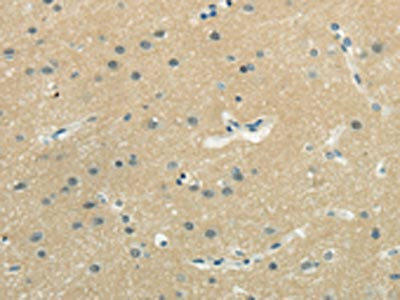Description
| Antibody Name: | WASF3 Antibody (PACO20871) |
| Antibody SKU: | PACO20871 |
| Size: | 50ul |
| Host Species: | Rabbit |
| Tested Applications: | ELISA, IHC |
| Recommended Dilutions: | ELISA:1:2000-1:5000, IHC:1:20-1:100 |
| Species Reactivity: | Human, Mouse |
| Immunogen: | Synthetic peptide of human WASF3 |
| Form: | Liquid |
| Storage Buffer: | -20°C, pH7.4 PBS, 0.05% NaN3, 40% Glycerol |
| Purification Method: | Antigen affinity purification |
| Clonality: | Polyclonal |
| Isotype: | IgG |
| Conjugate: | Non-conjugated |
 | The image on the left is immunohistochemistry of paraffin-embedded Human brain tissue using PACO20871(WASF3 Antibody) at dilution 1/25, on the right is treated with synthetic peptide. (Original magnification: x200). |
| Background: | This gene encodes a member of the Wiskott-Aldrich syndrome protein family. The gene product is a protein that forms a multiprotein complex that links receptor kinases and actin. Binding to actin occurs through a C-terminal verprolin homology domain in all family members. The multiprotein complex serves to tranduce signals that involve changes in cell shape, motility or function. A pseudogene of this gene have been defined on chromosome 6. Alternative splicing results in multiple transcript variants |
| Synonyms: | WAS protein family, member 3 |
| UniProt Protein Function: | WASF3: Downstream effector molecules involved in the transmission of signals from tyrosine kinase receptors and small GTPases to the actin cytoskeleton. Plays a role in the regulation of cell morphology and cytoskeletal organization. Required in the control of cell shape. Binds actin and the Arp2/3 complex. Expressed in ovary and brain. Belongs to the SCAR/WAVE family. |
| UniProt Protein Details: | Protein type:Actin-binding; Motility/polarity/chemotaxis Chromosomal Location of Human Ortholog: 13q12 Cellular Component: cytoskeleton; lamellipodium; cytoplasm Molecular Function:actin binding Biological Process: positive regulation of myelination; lamellipodium biogenesis; regulation of cell shape; actin filament polymerization; cytoskeleton organization and biogenesis; protein complex assembly; oligodendrocyte development |
| NCBI Summary: | This gene encodes a member of the Wiskott-Aldrich syndrome protein family. The gene product is a protein that forms a multiprotein complex that links receptor kinases and actin. Binding to actin occurs through a C-terminal verprolin homology domain in all family members. The multiprotein complex serves to tranduce signals that involve changes in cell shape, motility or function. A pseudogene of this gene have been defined on chromosome 6. Alternative splicing results in multiple transcript variants [provided by RefSeq, May 2014] |
| UniProt Code: | Q9UPY6 |
| NCBI GenInfo Identifier: | 13699803 |
| NCBI Gene ID: | 10810 |
| NCBI Accession: | NP_006637.2 |
| UniProt Secondary Accession: | Q9UPY6,O94974, Q86VQ2, |
| UniProt Related Accession: | Q9UPY6 |
| Molecular Weight: | 55,293 Da |
| NCBI Full Name: | wiskott-Aldrich syndrome protein family member 3 isoform 1 |
| NCBI Synonym Full Names: | WAS protein family, member 3 |
| NCBI Official Symbol: | WASF3 |
| NCBI Official Synonym Symbols: | SCAR3; WAVE3; Brush-1 |
| NCBI Protein Information: | wiskott-Aldrich syndrome protein family member 3; protein WAVE-3; WASP family Verprolin-homologous protein 3; verprolin homology domain-containing protein 3 |
| UniProt Protein Name: | Wiskott-Aldrich syndrome protein family member 3 |
| UniProt Synonym Protein Names: | Protein WAVE-3; Verprolin homology domain-containing protein 3 |
| Protein Family: | Wiskott-Aldrich syndrome protein family |
| UniProt Gene Name: | WASF3 |
| UniProt Entry Name: | WASF3_HUMAN |






